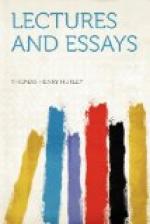Among the lower plants, it is the rule rather than the exception, that contractility should be still more openly manifested at some periods of their existence. The protoplasm of Algae and Fungi becomes, under many circumstances, partially, or completely, freed from its woody case, and exhibits movements of its whole mass, or is propelled by the contractility of one, or more, hair-like prolongations of its body, which are called vibratile cilia. And, so far as the conditions of the manifestation of the phaenomena of contractility have yet been studied, they are the same for the plant as for the animal. Heat and electric shocks influence both, and in the same way, though it may be in different degrees. It is by no means my intention to suggest that there is no difference in faculty between the lowest plant and the highest, or between plants and animals. But the difference between the powers of the lowest plant, or animal, and those of the highest, is one of degree, not of kind, and depends, as Milne-Edwards long ago so well pointed out, upon the extent to which the principle of the division of labour is carried out in the living economy. In the lowest organism all parts are competent to perform all functions, and one and the same portion of protoplasm may successfully take on the function of feeding, moving, or reproducing apparatus. In the highest, on the contrary, a great number of parts combine to perform each function, each part doing its allotted share of the work with great accuracy and efficiency, but being useless for any other purpose.
On the other hand, notwithstanding all the fundamental resemblances which exist between the powers of the protoplasm in plants and in animals, they present a striking difference (to which I shall advert more at length presently), in the fact that plants can manufacture fresh protoplasm out of mineral compounds, whereas animals are obliged to procure it ready made, and hence, in the long run, depend upon plants. Upon what condition this difference in the powers of the two great divisions of the world of life depends, nothing is at present known.
With such qualification as arises out of the last-mentioned fact, it may be truly said that the acts of all living things are fundamentally one. Is any such unity predicable of their forms? Let us seek in easily verified facts for a reply to this question. If a drop of blood be drawn by pricking one’s finger, and viewed with proper precautions, and under a sufficiently high microscopic power, there will be seen, among the innumerable multitude of little, circular, discoidal bodies, or corpuscles, which float in it and give it its colour, a comparatively small number of colourless corpuscles, of somewhat larger size and very irregular shape. If the drop of blood be kept at the temperature of the body, these colourless corpuscles will be seen to exhibit a marvellous activity, changing their forms with great rapidity, drawing in and thrusting out prolongations of their substance, and creeping about as if they were independent organisms.




